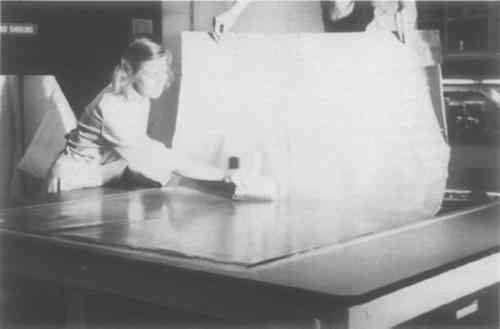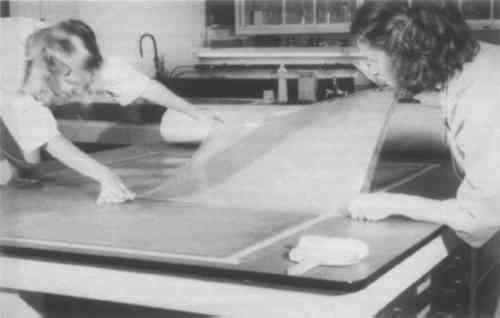TREATMENT AND MOUNTING OF A POSTER ANGLETERRE BY A.M. CASSANDREAntoinette Owen
4 BACKING TECHNIQUEGIVEN THE NUMBER OF LOSSES at the edges, the tears, and the general weakness of the paper, it was desirable to back the quadrants. A backing technique was selected that would involve a lateral drying tension of the quadrant in order to ameliorate the remaining ink/paper distortions. A sheet of .002 gauge Mylar was cut to the dimensions of the quadrant and smoothed onto a flat table surface. Strips of masking tape were laid down on the table surface 1� inches beyond each edge of the Mylar, as guidelines during the backing procedure. The quadrant was slowly wetted and brushed face down into smooth contact with the Mylar (Fig. 6). It required thorough saturation and some brushing manipulation to flatten the distortions and creases. When finally smooth, the quadrant had expanded a great deal.3 The backing procedure, therefore, was not begun until the flat quadrant had become damp rather than saturated and thus contracted almost to its original dimensions (using the Mylar to
As the tissues dried, a lateral stretch or drying tension was created. If the quadrant had been backed when fully expanded, the tension created probably would have caused damage either by tearing the poster or at the least separating repaired tears and pulp fills. The degree of tension of the quadrant was controlled by the degree of expansion of the quadrant at the time of backing. The Usugami tissues were fully wetted, then blotted of excess water before application. Backing with this system, although necessary because of the distortion problem, depended a great deal on judging the “moment of truth”, i.e. timing was essential. Drying of the poster was aided by application of large blotters and weights. All moisture was removed from the reverse. The blotters were changed periodically until the quadrant was completely dry. When removed from the tension system, each quadrant was flat and without distortions.4 |

